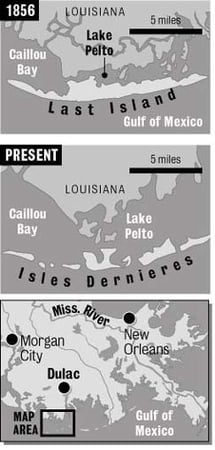The Last Island Hurricane
by Daphne Thompson, on Aug 10, 2016 1:51:43 PM
Have you ever heard of Last Island, Louisiana? This popular island resort is known for white sand beaches, clear water and continuous breezes. You can stay at the Ocean House Hotel or visit the Last Island Village, where around 100 beach homes are located. The Gulf breeze makes it a perfect spot to escape the heat and humidity of the mainland. At least, that's what people thought in the early 1800s.
Every summer in the 1800s, yellow fever threatened the residents in New Orleans and the surrounding area due to the stagnant swamp waters. An epidemic in 1853 claimed the lives of nearly 8,000 people. So, those who could afford it spent summers on islands nearby.
Last Island, or Isle Dernière, was exactly as it sounds, it was the last barrier island along the Louisiana coast. A ferry, named The Star, traveled twice a day to this 21 mile long stretch of white sand. Wealthy families spent summers here in large vacation homes. The 2-story hotel was a place for banquets and dances. It would have been a very relaxing spot to stay in the mid 1800s. The spot was so popular that a grand resort was planned to be built the next year in 1857.

On August 10, 1856, the weather was not the best for outdoor activities. It had been cloudy, the winds high, and the ocean rough the previous day, but now the waves were crashing onto the beach and rain was coming in torrents. Many decided to head back to the mainland on the ferry and left their homes to meet The Star, the only transportation available. However, due to strong winds, The Star was late after being blown off course and upon arrival it became beached. People headed back home and to the hotel, there would be no leaving the island.
 While people sheltered indoors, the winds began to increase. By afternoon, the wind was howling and lightning flashed across the sky. Vacationers were now scared, causing many to begin to move to more secure areas of their homes or to head to the hotel for safety. As midafternoon arrived, homes began to lose their roofs and walls began to be peeled away. At the hotel, the women and children were sent to the second floor while the men stayed below.
While people sheltered indoors, the winds began to increase. By afternoon, the wind was howling and lightning flashed across the sky. Vacationers were now scared, causing many to begin to move to more secure areas of their homes or to head to the hotel for safety. As midafternoon arrived, homes began to lose their roofs and walls began to be peeled away. At the hotel, the women and children were sent to the second floor while the men stayed below.
Around 5:00pm, the storm surge hit. Up to 12 feet of water hit and island thought to be no more than five feet above sea level. The hotel collapsed crushing many and causing others to be swept out to sea. Every home on Last Island was washed away, as it was submerged by water. Some survivors clung to trees or debris while others sheltered inside the hull of the grounded ferry. Out of approximately 400 vacationers, only 203 survived.
Last Island was not one of the survivors. It broke up into five smaller islands, as many areas were completely washed away. The hurricane that hit is believed to have been a Category 4, with wind speeds of 150 mph at max intensity. It made landfall just south of New Iberia, Louisiana.
We have better data now than we did 160 years ago. Satellite data shows where a hurricane is forming, ships provide data, buoys tell us about ocean temperature, planes fly into them to measure winds and computer models forecast paths. Yet, many still vacation on the beach in condos and homes that are susceptible to storm surge. Danger zones exist in numerous locations along our coastlines and history has shown that many still don't take appropriate action when a hurricane approaches. Our WeatherOps team can help by providing site-specific forecasts and giving you plenty of lead time to prepare. Try a free 7-day trial today.








